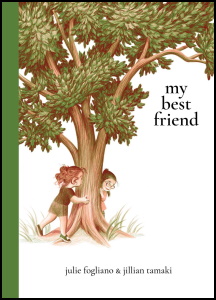Picture books aimed at the very young don't often garner Caldecott recognition, but they are worthy of our attention — including My Best Friend, written by Julie Fogliano and illustrated by Jillian Tamaki.
 I admit it -- I am a proponent of picture books aimed at the very young, and I am aware that these books don’t often garner Caldecott recognition. But they deserve our attention.
I admit it -- I am a proponent of picture books aimed at the very young, and I am aware that these books don’t often garner Caldecott recognition. But they deserve our attention.
So here's one: My Best Friend, written by Julie Fogliano and illustrated by Jillian Tamaki. It's the story of a small child's day at a playground, meeting another child and immediately becoming fast friends, as preschoolers are wont to do. The two laugh and spin in circles and imitate ducks and draw with chalk and find a hiding place where they can go when they want to be quiet. The text is careful not to use dialogue -- it's clear that these are very young children, not pre-verbal most probably, but communicating in mostly nonverbal ways. (They don't even learn each other's names, these two new best friends.) In other words, it's utterly true to preschooler behavior.
Tamaki here does some very interesting things: with white space, with composition, with perspective, with (by choice) a severely limited palette. Most of all, she uses THE PAGE-TURN, that best tool and gift of the picture book form. (See Jules's recent post on reading picture books digitally for more discussion of the importance of page-turns.)
The book opens, before the title page, with an extremely up-close portrait of our narrator's face. Tamaki has invested that face with an intensity of emotion and has communicated it so clearly to viewers -- we don't yet know why, but we see that the little girl's face is full of alertness and anticipation and interest and expectation.
Then comes THE PAGE-TURN -- and Tamaki pulls back to show us the setting: a playground. And we see the object of the little girl's interest. We see that she is gazing shyly, from a distance, at another little girl, sitting alone on a tire swing. One more page-turn and the text of the book begins: “I have a new friend.” And now the two girls are swinging together on the tire swing, heads thrown back in pure joy.
So, after just three page-turns we are fully into the action and emotions experienced by this small child on her intensely-friend-focused day at the park.
That's one of the remarkable things about this book. Another is the limited palette of complementary colors, with which Tamaki accomplishes a LOT. The basic colors are browns -- in a range from a rich russet to a warm peach -- and greens, against a cream background. But she does so much within those limitations. Take the new friend's hair, which is described as black, and indeed it presents as black, but it's not — instead, Tamaki uses dark browns mixed with green. The effect is black hair reflecting sunlight.
The compositions here effectively utilize shapes to focus viewers' attention -– the triangle of the swingset and the circle of the tire, echoed in the circular shape the two girls’ arms make as they join hands to twirl around in circles (and fall, laughing, on their bums).
[Read the Horn Book Magazine review of My Best Friend]
My Best Friend is a simple story, but its execution reflects care, sophistication, and respect for its audience. Jillian Tamaki is a prodigious and versatile talent, and a close observer of people and human nature. This last quality is evident as well in her other 2020 picture book, the wonderful Our Little Kitchen—which is illustrated in a totally different style but captures characters' expressions, postures, and personalities, just as My Best Friend does. (You can see a spread from Our Little Kitchen here.) I hope you get to see both of Tamaki's 2020 picture books, and let us know your thoughts.
ALREADY A SUBSCRIBER? LOG IN
We are currently offering this content for free. Sign up now to activate your personal profile, where you can save articles for future viewing.








Add Comment :-
Comment Policy:
Comment should not be empty !!!
Bill Wright
Absolutely lovely book...reminds me a whole lot of Robert McCloskey's illustrations...and one that my class chose as an honor book in their mock Caldecott. HOWEVER...according to Jillian Tamaki's website, she was born in Edmonton, Alberta and lives in Toronto, Ontario. (She lived in Brooklyn when she honored for her graphic novel.) Any idea if she still maintains a residence in the US? Otherwise she wouldn't be eligible, correct? Either way, I decided we should keep her book on our list, either as an honor book, or an "international honourable mention"! Thanks for any help...can't wait for Monday! Bill:)Posted : Jan 23, 2021 12:33
Angela Reynolds
I love how the emotions and vibrancy of these two characters is portrayed in a limited colour palette. The imaginative drawings really hit the mark in expanding the story. And I adore the pickle spread!Posted : Oct 20, 2020 02:43